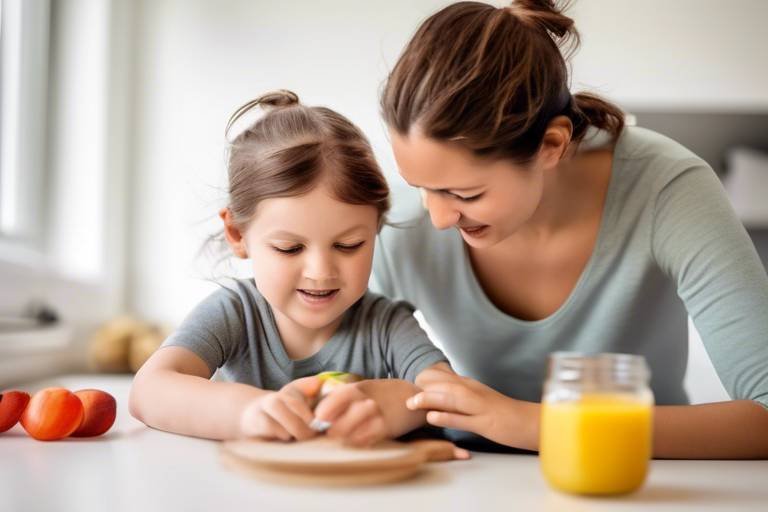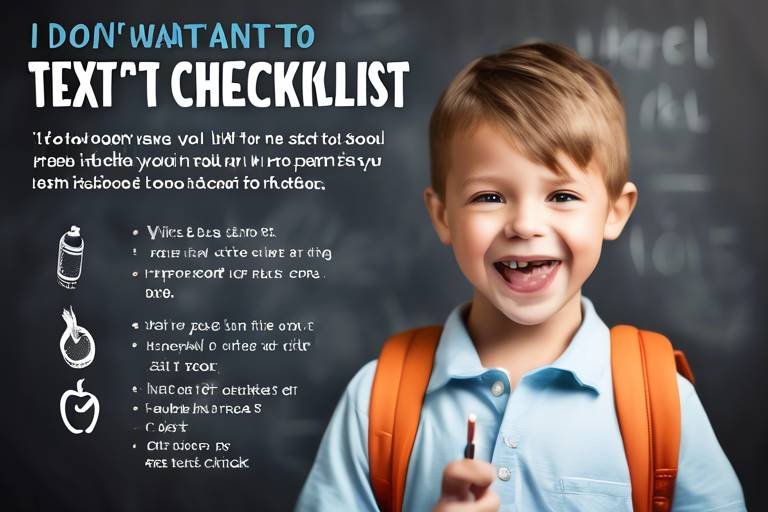Creating Better Health Routines for Your Kids
Establishing healthy routines for your kids is not just a good idea; it's a necessity in today’s fast-paced world. With the rise of technology and fast food, children are increasingly at risk of developing unhealthy habits that can last a lifetime. So, how do you combat this? The answer lies in creating a balanced lifestyle that encompasses nutrition, physical activity, and mental well-being. By focusing on these key areas, you can help your children develop routines that promote their overall health and happiness.
Imagine your child's body as a garden. Just as a garden needs sunlight, water, and nutrients to thrive, so does your child require a balanced diet, physical activity, and mental care to grow into a healthy adult. The good news is that you can start laying down the roots for these healthy habits today. In this article, we will explore effective strategies for establishing these routines, making it easier for both you and your children to embrace a healthier lifestyle.
But let’s be real—getting kids to eat their veggies or put down the video game can feel like a monumental task. However, with the right strategies and a little creativity, you can turn this challenge into a fun and engaging experience. After all, who said health routines have to be boring? Let’s dive into the essential elements that will help you create better health routines for your kids!
Understanding the role of nutrition in children's growth and development is crucial. Proper nutrition fuels their bodies and minds, enabling them to learn, play, and grow. Kids need a variety of nutrients to stay healthy, including vitamins, minerals, proteins, and healthy fats. But how do you ensure they’re getting all the goodness they need?
One effective strategy is to make healthy eating a family affair. Get your kids involved in meal planning and preparation. This not only teaches them about nutrition but also makes them more likely to try new foods. Here are some essential nutrients to focus on:
- Fruits and Vegetables: Aim for a colorful plate. The more colors, the more nutrients!
- Whole Grains: Choose whole-grain bread, pasta, and cereals for added fiber.
- Proteins: Incorporate lean meats, beans, and nuts into meals.
- Dairy: Opt for low-fat milk, yogurt, and cheese for calcium.
By making small changes and encouraging your kids to try new foods, you can significantly improve their nutrition without them even realizing it!
Regular physical activity is vital for children's health. It helps build strong bones and muscles, improves cardiovascular fitness, and contributes to a healthy weight. But how much exercise do kids actually need? According to the CDC, children should get at least 1 hour of physical activity every day. This can include a mix of aerobic, muscle-strengthening, and bone-strengthening activities.
Exploring various types of exercises suitable for children can make staying active fun. Here’s a quick breakdown of the different types of exercises:
| Type of Exercise | Description |
|---|---|
| Aerobic | Activities like running, swimming, or cycling that increase heart rate. |
| Strength-building | Using body weight or light weights to build muscle. |
| Flexibility | Stretching exercises to improve flexibility and prevent injuries. |
Engaging kids in outdoor activities not only promotes fitness but also enhances their connection with nature. Think about games like tag, soccer, or even a nature scavenger hunt. These activities are not only enjoyable but also encourage teamwork and social interaction.
For those rainy days when outdoor play isn't feasible, consider indoor options like dance parties, yoga, or even simple obstacle courses made from household items. The key is to keep it fun and varied!
Establishing healthy routines requires consistency. It’s important to make healthy choices a natural part of your child's daily life. Here are some techniques to instill positive habits:
- Lead by example—show your kids that you value health.
- Set specific times for meals and exercise.
- Celebrate small victories to keep motivation high.
Mental health is just as important as physical health. It’s essential to foster emotional resilience and mindfulness in children. This can be achieved through simple practices that promote a balanced lifestyle.
Introducing mindfulness techniques can help children manage stress and enhance focus. Simple strategies like deep breathing exercises, meditation, or even mindful coloring can make a big difference in how your child handles stress.
Creating an environment where children feel comfortable discussing their feelings is essential for mental health. Encourage them to share their thoughts and emotions openly. This not only strengthens your bond but also helps them develop emotional intelligence.
Q: How can I get my child to eat healthier?
A: Involve them in meal planning and preparation, and make healthy foods fun to eat!
Q: What are some fun ways to encourage physical activity?
A: Organize family games, explore new sports together, or set up a weekly family hike.
Q: How can I promote mental well-being in my child?
A: Encourage open dialogue about feelings and introduce mindfulness exercises into their routine.

Importance of Nutrition
Understanding the role of nutrition in children's growth and development is crucial. Just like a car needs the right fuel to run smoothly, kids require a balanced diet to thrive. Nutrition is the foundation that supports their physical and mental growth, helping them build strong bones, develop their brains, and maintain energy levels throughout the day. So, what does a healthy diet look like for our little ones? It's not just about avoiding junk food; it's about incorporating a variety of essential nutrients into their meals.
Essential nutrients play a vital role in children's health. Here’s a quick breakdown:
| Nutrient | Benefits | Sources |
|---|---|---|
| Protein | Supports growth and muscle development | Meat, fish, eggs, beans, and nuts |
| Calcium | Strengthens bones and teeth | Dairy products, leafy greens, and fortified foods |
| Iron | Essential for oxygen transport in the body | Red meat, poultry, beans, and spinach |
| Vitamins | Supports immune function and overall health | Fruits, vegetables, and whole grains |
To make healthy eating fun and engaging, it’s important to involve your kids in the kitchen. Cooking together can turn into a delightful bonding experience while teaching them about nutrition. Try to create a colorful plate filled with a variety of fruits and vegetables; this not only looks appealing but also ensures they get a wide range of nutrients. You might say, "Eating the rainbow" is not just a catchy phrase; it’s a great way to encourage them to try new foods!
Moreover, it’s essential to set a good example as parents. Kids are like sponges; they absorb what they see. If they observe you making healthy food choices, they are more likely to mimic those behaviors. Encourage family meals without distractions, allowing everyone to appreciate and enjoy their food together. This practice not only fosters healthy eating habits but also strengthens family bonds.
Incorporating healthy snacks into their daily routine is also a smart strategy. Instead of reaching for chips or candy, opt for options like:
- Fresh fruit slices with nut butter
- Yogurt with a sprinkle of granola
- Veggie sticks with hummus
These choices provide essential nutrients while satisfying their cravings. Remember, it’s not about strict diets but rather about creating a balanced approach to eating that your children can carry with them into adulthood.
In conclusion, nutrition is a fundamental pillar of health for children. By focusing on a balanced diet rich in essential nutrients and fostering a positive relationship with food, you can set your kids up for a lifetime of healthy habits. It’s all about making small, sustainable changes that can lead to big results over time. So, let’s get cooking and enjoy the journey of nourishing our children!

Physical Activity Guidelines
When it comes to keeping our kids healthy, regular physical activity plays a pivotal role. It's more than just a way to burn off energy; it's a cornerstone of their overall well-being. The World Health Organization recommends that children aged 5 to 17 engage in at least 60 minutes of moderate to vigorous physical activity each day. This might sound daunting, but the good news is that it can be fun and engaging! Think of it as an adventure rather than a chore. Who wouldn't want to be a superhero or a jungle explorer for an hour every day?
Incorporating exercise into your child's routine doesn’t have to be a serious affair. The key is to make it enjoyable. Activities can range from riding a bike, playing tag, or even dancing around the living room to their favorite tunes. The idea is to get them moving, and as parents, we can be the ultimate role models. When they see us participating in physical activities, they are more likely to join in. So, lace up those sneakers and let’s get moving!
There are various types of exercises suitable for children, each offering unique benefits. Understanding these can help you tailor activities to your child's interests and needs. Here’s a quick breakdown:
| Type of Exercise | Description | Examples |
|---|---|---|
| Aerobic | Activities that increase heart rate and breathing. | Running, swimming, cycling |
| Strength-building | Exercises that improve muscle strength. | Bodyweight exercises, resistance bands |
| Flexibility | Activities that enhance flexibility and range of motion. | Yoga, stretching |
This table summarizes the three main types of exercises that can be easily integrated into your child’s daily routine. Each type has its own set of benefits, and mixing them up can keep things fresh and exciting. For instance, a fun day at the park might include running around (aerobic), climbing on jungle gyms (strength-building), and finishing with some light stretching (flexibility).
Engaging kids in outdoor activities not only promotes fitness but also enhances their connection with nature. Outdoor play is a fantastic way to let kids explore their environment while getting the exercise they need. Some enjoyable outdoor games include:
- Capture the Flag: A classic game that involves running and strategy.
- Obstacle Courses: Set up a course in your backyard using everyday items.
- Nature Scavenger Hunts: Encourage exploration by searching for specific plants or animals.
These activities not only keep kids active but also foster teamwork and creativity. Plus, they get to enjoy the fresh air and sunshine, which is a win-win!
For those days when outdoor play isn't feasible—maybe it’s raining or too hot—there are plenty of creative indoor exercise options. Think of it as a mini adventure inside! Here are some ideas:
- Dance Parties: Crank up the music and let loose!
- Indoor Obstacle Courses: Use pillows, furniture, and blankets to create a fun course.
- Fitness Videos: There are tons of kid-friendly workout videos available online.
These indoor activities can keep children physically engaged while also sparking their imagination. Remember, the goal is to keep them moving, even if it means turning your living room into a dance floor!
Ultimately, establishing a routine that incorporates physical activity is vital for your child's health. It’s about creating a lifestyle that values movement and fun, ensuring that your kids grow up with a positive relationship with exercise. After all, wouldn’t you want your children to view physical activity as a joyful part of their lives rather than a chore?
Q: How can I motivate my child to be more active?
A: Try to make physical activity part of your family routine. Join in on the fun, and let them choose activities they enjoy. Celebrating small achievements can also boost their motivation!
Q: What if my child prefers screen time over outdoor play?
A: Set limits on screen time and encourage active games that incorporate technology, such as dance video games or augmented reality games that require movement.
Q: How can I ensure my child stays safe while being active?
A: Always supervise your child during physical activities, ensure they wear appropriate gear, and teach them about safety rules for different sports and exercises.

Types of Exercises
When it comes to keeping our kids active, variety is the spice of life! Just like a well-balanced meal, a mix of different types of exercises can keep children engaged and excited about physical activity. There are three main categories of exercise that are particularly beneficial for children: aerobic exercises, strength-building exercises, and flexibility exercises. Each type has its unique benefits and can easily be woven into your child's daily routine.
Aerobic exercises are all about getting that heart pumping! Activities like running, swimming, and cycling not only improve cardiovascular health but also help to build endurance. Imagine your child racing around the park, their laughter echoing as they chase after friends. This kind of play not only keeps them fit but also boosts their mood and energy levels. Aim for at least 60 minutes of moderate to vigorous aerobic activity each day. It sounds like a lot, but it can be broken down into fun bursts throughout the day!
Strength-building exercises might sound intimidating, but they can be as simple as playing on the jungle gym or doing push-ups against a wall. These activities help develop strong muscles and bones, which is essential for growing kids. Think of it this way: just like a tree needs a sturdy trunk to withstand the wind, children need strong muscles to support their growing bodies. Simple exercises like
- bodyweight squats
- climbing
- playing tug-of-war
Lastly, we have flexibility exercises, which are often overlooked but are just as important. Stretching activities, yoga, and even playful movements like dancing help improve flexibility and reduce the risk of injury. Picture your child attempting a yoga pose, giggling as they try to balance—this not only enhances their physical ability but also promotes relaxation and focus. Incorporating a few minutes of stretching into their routine can make a huge difference in their overall physical health.
To help you visualize these types of exercises, here’s a quick table summarizing their benefits:
| Type of Exercise | Benefits |
|---|---|
| Aerobic | Improves cardiovascular health, boosts energy, enhances mood |
| Strength-building | Develops strong muscles and bones, enhances physical resilience |
| Flexibility | Improves flexibility, reduces injury risk, promotes relaxation |
Incorporating these types of exercises into your child's routine doesn't have to be a chore. Think of it as an adventure! Whether it’s a family hike, a dance party in the living room, or a fun obstacle course in the backyard, the key is to keep it fun and engaging. By mixing these exercises, you’ll not only help your child develop a love for physical activity but also set them on the path to a healthier lifestyle that they can carry into adulthood.
Q: How much exercise should my child get each day?
A: Children should aim for at least 60 minutes of physical activity every day, which can include a mix of aerobic, strength-building, and flexibility exercises.
Q: What are some fun ways to encourage my child to be active?
A: You can encourage activity by organizing family outings that include hiking, biking, or playing sports together. Making it a family affair can motivate kids to participate!
Q: Can indoor activities be just as beneficial as outdoor ones?
A: Absolutely! Activities like dancing, yoga, or even playing active video games can keep children engaged and physically active, even when they can't go outside.

Outdoor Activities
Engaging kids in is not just about burning off energy; it's about fostering a lifelong love for movement and nature. Imagine your child running through a field, laughter echoing, as they kick a soccer ball or ride their bike down a sunny path. These moments are not only fun but also crucial for their physical and emotional development. Outdoor play allows children to explore their surroundings, develop social skills, and build confidence as they attempt new activities.
So, what are some fantastic outdoor activities that can keep your kids active and entertained? Here are a few ideas:
- Nature Scavenger Hunts: Create a list of items for your kids to find in your backyard or a nearby park. This can include things like a pinecone, a specific flower, or a feather. Not only does this keep them moving, but it also encourages them to observe and appreciate their environment.
- Obstacle Courses: Set up a simple obstacle course using items around the house or park. Kids can jump over ropes, crawl under tables, or balance on logs. This not only enhances their physical skills but also adds an element of fun and challenge.
- Outdoor Sports: Whether it's soccer, basketball, or frisbee, playing sports is a great way to get kids moving. You can organize small games with friends or family, fostering teamwork and communication skills.
- Gardening: Believe it or not, gardening can be a fantastic workout! Kids can dig, plant, and water, all while learning about nature and responsibility. Plus, they’ll be excited to see the fruits (or vegetables) of their labor!
These activities not only promote physical fitness but also enhance your child's connection with nature. As they engage in outdoor play, they're likely to develop a sense of adventure and curiosity about the world around them. Plus, there’s something magical about fresh air and sunshine that simply can’t be replicated indoors.
It's essential to encourage a routine that incorporates outdoor play into your child's daily life. Whether it’s a family hike on weekends or a trip to the park after school, consistency is key. Make it a habit to step outside, breathe in the fresh air, and enjoy the simple pleasures of being active together. Remember, the goal is to create positive associations with physical activity, so keep it fun and light-hearted!
Q: How much outdoor play should my child get daily?
A: Ideally, children should aim for at least 1 hour of physical activity each day. This can include a mix of structured sports and free play outdoors.
Q: What if my child prefers indoor activities?
A: While indoor activities can be fun, try to incorporate outdoor play gradually. Start with short sessions outside and mix in activities they enjoy to make it more appealing.
Q: How can I make outdoor play more engaging?
A: Incorporate games, challenges, or themed playdates that revolve around outdoor activities. This can include scavenger hunts, nature walks, or sports competitions.

Indoor Exercise Options
When the weather outside is less than inviting, it can be a challenge to keep kids active and engaged. But fear not! There are plenty of that can turn a gloomy day into a fun-filled adventure. Think of it as transforming your living room into a mini gym or an obstacle course. The key is to get creative and make exercise feel like play rather than a chore.
One fantastic way to keep kids moving indoors is through dance parties. Crank up their favorite tunes and let them dance like nobody's watching! Not only does this get their heart rate up, but it also allows them to express themselves. Plus, you can join in too, making it a great family bonding activity. Remember, dancing isn’t just about moving to the beat; it’s about feeling the rhythm and having fun!
If you're looking for something a bit more structured, consider setting up a mini obstacle course in your home. Use pillows, chairs, and blankets to create hurdles and challenges. Time your kids as they navigate the course, and watch as they race against their own records. This not only promotes physical activity but also enhances their problem-solving skills as they figure out the best way to tackle each obstacle.
For those who enjoy a bit of competition, indoor sports can also be a hit. You can play games like indoor basketball using a soft ball and a laundry basket or even set up a mini soccer game in a spacious area. These activities can help develop coordination and teamwork, all while keeping the energy levels high. Don’t forget to cheer each other on; it adds to the excitement!
Another great option is to incorporate fitness videos or apps designed for kids. Many platforms offer fun workouts that are engaging and age-appropriate. From yoga to high-energy workouts, these videos can guide children through routines that keep them active while learning new skills. Plus, it can be a fun way to introduce them to different types of exercises.
Lastly, if you have the space, consider setting up a yoga corner for some calming indoor activity. Yoga not only promotes flexibility but also teaches kids to focus on their breathing and relax. There are many kid-friendly yoga videos available that can guide them through fun poses and breathing exercises. This can be a great way to wind down after a busy day.
In conclusion, indoor exercise options are abundant and can be tailored to fit any child's interests and energy levels. The goal is to keep them moving while having fun, so don’t hesitate to mix and match these ideas. Remember, the more enjoyable the activity, the more likely they are to stick with it!
Q: How can I motivate my child to exercise indoors?
A: Make it fun! Turn exercise into a game or a dance party. Engage with them, and participate in the activities to keep their spirits high.
Q: What if my child doesn't like traditional exercises?
A: Explore various activities like dancing, yoga, or even playing indoor sports. The key is to find what they enjoy the most.
Q: How much indoor exercise should my child get?
A: Aim for at least 30 minutes of physical activity each day, but remember that any movement counts! Incorporate short bursts of activity throughout the day.

Building Healthy Habits
Establishing healthy routines for children is not just a task; it’s a journey that requires patience and consistency. Imagine teaching your child to ride a bike. At first, they may wobble and fall, but with your encouragement and practice, they eventually find their balance. Similarly, building healthy habits is all about creating a supportive environment where children can thrive. The key is to make these habits feel natural, as effortless as breathing. You want them to reach for an apple instead of a candy bar without even thinking about it!
One effective way to instill these habits is by leading by example. Children are like sponges; they absorb everything around them. If they see you enjoying a colorful plate of fruits and vegetables, they’re more likely to mimic that behavior. So, why not make mealtimes a family affair? Involve your kids in the cooking process. This not only teaches them about nutrition but also allows them to take ownership of their food choices. You could create a weekly meal plan together, emphasizing the importance of variety in their diets. Here’s a simple table to illustrate how you might plan your meals:
| Day | Breakfast | Lunch | Dinner |
|---|---|---|---|
| Monday | Oatmeal with fruits | Turkey sandwich | Grilled chicken with veggies |
| Tuesday | Smoothie bowl | Quinoa salad | Spaghetti with tomato sauce |
| Wednesday | Scrambled eggs and toast | Vegetable stir-fry | Fish tacos |
Another important aspect is to create a routine around physical activity. Just like brushing their teeth, exercise should become a non-negotiable part of their day. Set aside time for family walks, bike rides, or even dance parties in the living room. The goal is to make it fun! If your kids associate physical activity with joy, they will be more inclined to engage in it regularly. You could even set up a reward system to encourage them. For instance, after a week of active play, treat them to a movie night or a small toy. This not only motivates them but also reinforces the idea that being active is rewarding.
Consistency is crucial, but it’s also essential to remain flexible. Life can be unpredictable, and sometimes routines will be disrupted. If a busy week means skipping the family bike ride, that’s okay! The key is to get back on track without guilt. Teach your children that it’s okay to have off days, and what matters is the overall trend towards healthy living. To solidify these habits, consider incorporating a health journal where your kids can track their meals and activities. This not only fosters a sense of responsibility but also helps them reflect on their choices.
Lastly, don’t underestimate the power of open communication. Discuss with your children why these habits are important. Use relatable analogies, like comparing a balanced diet to putting together a colorful puzzle. Each food group is a piece that completes the picture of their health. When children understand the 'why' behind their habits, they are more likely to embrace them wholeheartedly. Remember, building healthy habits is a marathon, not a sprint. With your guidance and love, your children will develop the tools they need to lead healthy, fulfilling lives.
- How can I make healthy eating fun for my kids? Involve them in meal planning and preparation, and make colorful, creative dishes that are visually appealing!
- What if my child refuses to try new foods? Encourage them gently without pressure. Sometimes it takes multiple exposures to a new food before they accept it.
- How much physical activity do kids need? Aim for at least 60 minutes of moderate to vigorous activity each day, but remember to keep it fun!

Mental Well-being Practices
Mental health is just as important as physical health, especially for children who are navigating the complexities of growing up. Understanding this, parents and caregivers need to foster an environment that supports emotional well-being. By prioritizing mental health, we can help our kids build resilience, manage stress, and develop a positive self-image. But how do we do this effectively? Let’s dive into some practical strategies that can make a significant difference in your child's life.
One of the most impactful ways to nurture mental well-being is through mindfulness techniques. Mindfulness encourages children to focus on the present moment, helping them to reduce anxiety and improve their concentration. You might be wondering how to introduce mindfulness to your little ones. Simple practices like deep breathing exercises, guided imagery, or even mindful coloring can be incredibly effective. For instance, you could sit together and take deep breaths, counting to four as you inhale and exhale. This not only calms the mind but also creates a bonding experience.
In addition to mindfulness, encouraging open communication is crucial. Children need to feel safe and comfortable expressing their feelings. As parents, you can create this environment by actively listening and validating their emotions. When your child shares their thoughts, resist the urge to immediately offer solutions; instead, ask open-ended questions that promote discussion. For example, if your child is upset about a tough day at school, ask them, “What was the hardest part of your day?” This shows them that their feelings are important and worth discussing, fostering emotional intelligence.
Moreover, establishing a routine that includes time for relaxation and reflection can greatly enhance your child’s mental well-being. Consider creating a calm-down corner in your home, a special space where they can retreat when feeling overwhelmed. Fill it with comforting items like pillows, books, or art supplies, allowing them to unwind and express themselves creatively. This designated area can serve as a sanctuary for your child, reinforcing the idea that it's perfectly okay to take a break when needed.
To further support mental well-being, it’s essential to integrate physical activity into your child's daily routine. Engaging in regular exercise not only boosts physical health but also releases endorphins, which are natural mood lifters. Encourage your kids to participate in activities they enjoy, whether it’s dancing, biking, or playing a sport. The key is to make it fun! When children associate physical activity with enjoyment, they are more likely to stick with it long-term.
Lastly, remember that your child learns by example. By modeling healthy mental habits, you can inspire them to adopt similar practices. Share your own experiences with stress and how you cope with it. Whether it's taking a walk, journaling, or practicing yoga, showing your children that everyone has challenges and that there are constructive ways to deal with them can be incredibly empowering.
- What are some signs that my child may be struggling with their mental health?
Look for changes in behavior, such as withdrawal from friends, changes in mood, or a drop in academic performance. If you notice these signs, it may be time to have an open conversation with your child. - How can I encourage my child to practice mindfulness?
Start with short sessions, using apps or videos designed for kids. Make it a fun, family activity, perhaps by practicing together at home. - What should I do if my child refuses to talk about their feelings?
Sometimes children may not have the words to express themselves. Encourage them to use art or writing as a means of communication, and reassure them that you are there to listen whenever they are ready.

Mindfulness Techniques
In today's fast-paced world, where distractions lurk around every corner, teaching children can be a game-changer. Mindfulness is all about being present in the moment, and it can help kids manage stress, improve their focus, and foster emotional resilience. So, how can we introduce these powerful techniques to our little ones? Let’s dive into some practical methods!
One effective way to start is through breathing exercises. These can be as simple as taking a few deep breaths together. Encourage your child to inhale deeply through their nose, hold it for a moment, and then exhale slowly through their mouth. You could even turn it into a fun game by counting how many breaths they can take in a minute. This not only calms their mind but also helps them become aware of their bodies and feelings.
Another engaging technique is the body scan. This practice involves guiding your child to focus on different parts of their body, starting from the toes and moving up to the head. Ask them to notice any sensations, whether it's tension or relaxation. This can be a wonderful way to help them connect with their physical selves and understand how emotions manifest in their bodies. You can make it even more enjoyable by using a soft, soothing voice or playing calming music in the background.
For visual learners, guided imagery can be an effective mindfulness practice. Paint a vivid picture with your words, describing a serene place like a beach or a forest. Encourage your child to visualize themselves in that space, noticing the sights, sounds, and smells around them. This technique not only fosters creativity but also provides a mental escape, helping them to relax and unwind.
Incorporating mindful movement can also be beneficial. Activities like yoga or tai chi allow children to combine physical activity with mindfulness. You can find child-friendly yoga videos online that guide them through simple poses while emphasizing breath and focus. This not only promotes physical health but also teaches them to be aware of their movements and how they feel in their bodies.
Lastly, creating a mindfulness jar can be a fun and interactive way to reinforce these techniques. Fill a clear jar with water and glitter, and whenever your child feels overwhelmed, they can shake the jar and watch the glitter settle. As the glitter falls, encourage them to take deep breaths and visualize their thoughts settling just like the glitter. This visual representation can help them understand that feelings can be temporary and manageable.
By practicing these mindfulness techniques regularly, you're not just teaching your kids to cope with stress; you're also equipping them with valuable life skills that will serve them well into adulthood. Remember, the key to mindfulness is consistency and patience. So, make it a family affair—practice together and turn it into a bonding experience!
- What age can children start practicing mindfulness? Children can start practicing mindfulness as early as 3 years old, with simple techniques tailored to their developmental stage.
- How long should mindfulness sessions be? Start with just a few minutes and gradually increase the duration as your child becomes more comfortable with the practice.
- Can mindfulness help with anxiety in children? Yes, mindfulness techniques can significantly reduce anxiety by helping children focus on the present moment instead of worrying about the future.
- Should I practice mindfulness with my child? Absolutely! Practicing together not only sets a great example but also strengthens your bond.

Encouraging Open Communication
When it comes to nurturing a child's mental health, open communication is absolutely essential. Think of it as the foundation of a sturdy house; without it, everything else can easily crumble. Children need to feel that they can express their thoughts and emotions freely, without fear of judgment or reprimand. But how can we foster this kind of environment? It starts with us, the parents and caregivers, being approachable and willing to listen.
One effective way to encourage open communication is by establishing a routine where you regularly check in with your child. This could be during dinner, bedtime, or any time that feels natural. Ask them about their day, their feelings, and even their dreams. You might be surprised at what they share! For instance, instead of asking, "How was school?" try asking, "What was the best part of your day?" This subtle shift can lead to more engaging conversations.
It's also important to practice active listening. This means not just hearing their words, but really understanding the emotions behind them. Show them that their feelings are valid and important. You can say things like, "I understand that you're feeling upset about that," or "It's okay to feel anxious sometimes." This validation can go a long way in helping children feel safe and understood.
In addition, creating a safe space for sharing can help immensely. This doesn't necessarily mean a physical space; it can also be about the emotional climate you foster. Encourage your child to share their feelings by using non-judgmental language. For example, instead of reacting with shock or anger when they reveal something troubling, respond with curiosity and empathy. You might say, "Thank you for telling me that. I'm here to help you work through it." This encourages them to come to you with future concerns.
Furthermore, using storytelling can be a powerful tool. Sharing your own experiences, including your struggles and how you overcame them, can help children relate. They might feel less alone in their own challenges when they see that even adults face difficulties. You might say, "When I was your age, I also felt nervous about trying new things, but I learned that it’s okay to feel that way." This not only opens the door for conversation but also strengthens your bond.
Lastly, remember that open communication is a two-way street. Encourage your child to ask questions, express their opinions, and even challenge you respectfully. This not only builds their confidence but also teaches them the importance of dialogue. As a parent, you can model this behavior by being open about your own feelings and thoughts. It’s a beautiful way to show them that everyone has emotions and that discussing them is healthy.
In summary, fostering open communication with your children is a vital step in supporting their mental well-being. By creating a safe environment for sharing, practicing active listening, and encouraging them to express themselves, you can help your child develop emotional resilience. Remember, the more they feel heard, the more likely they are to come to you when they need support.
- How can I tell if my child is comfortable communicating with me?
Look for signs like them sharing their thoughts and feelings openly, asking questions, and seeking your advice on various matters. If they seem hesitant or avoidant, it might be time to work on building that comfort level.
- What should I do if my child is reluctant to talk?
Give them space but also gently encourage them. Sometimes, engaging them in activities they enjoy can open the door to conversations. You might find that they are more willing to share during a casual game or while driving.
- Are there specific phrases I should avoid when talking to my child?
Yes, avoid using dismissive phrases like "You're overreacting" or "Just get over it." Instead, validate their feelings and encourage them to express themselves.
Frequently Asked Questions
- What are some easy ways to improve my child's nutrition?
Improving your child's nutrition can be as simple as incorporating more fruits and vegetables into their meals. Try making smoothies with spinach and bananas or adding colorful veggies to their favorite dishes. Also, involve them in meal planning and preparation to make healthy eating fun!
- How much physical activity should my child get each day?
Children should aim for at least 60 minutes of physical activity every day. This can include anything from playing tag at the park to riding their bike around the neighborhood. The key is to make it enjoyable so they look forward to being active!
- What types of exercises are best for kids?
Kids benefit from a mix of aerobic exercises (like running or swimming), strength-building activities (like climbing or push-ups), and flexibility exercises (like stretching or yoga). The goal is to keep it varied and fun!
- How can I encourage my child to play outside more?
Set up outdoor playdates, organize family hikes, or create a backyard scavenger hunt. The more fun activities you can introduce, the more likely your child will be excited to spend time outside!
- What indoor activities can keep my child active?
When outdoor play isn't an option, consider indoor activities like dance parties, obstacle courses made from pillows and furniture, or even fun workout videos designed for kids. Keeping things lively and engaging is key!
- How can I help my child build healthy habits?
Consistency is crucial! Establish a routine that includes regular meal times, designated playtimes, and quiet times for relaxation. Praise your child for making healthy choices, and lead by example—kids learn a lot from watching their parents!
- Why is mental well-being important for kids?
Mental well-being is essential as it affects how children think, feel, and behave. Promoting good mental health helps them handle stress, build relationships, and make better choices. It’s just as important as physical health!
- What are some mindfulness techniques I can teach my child?
Start with simple breathing exercises, where they take deep breaths in and out. You can also encourage them to focus on their five senses—what they see, hear, smell, touch, and taste. These techniques can help them stay calm and centered.
- How can I encourage my child to talk about their feelings?
Create a safe and open environment where your child feels comfortable expressing themselves. Ask open-ended questions, listen actively, and validate their feelings. Regularly check in with them about their day to keep the lines of communication open.



















